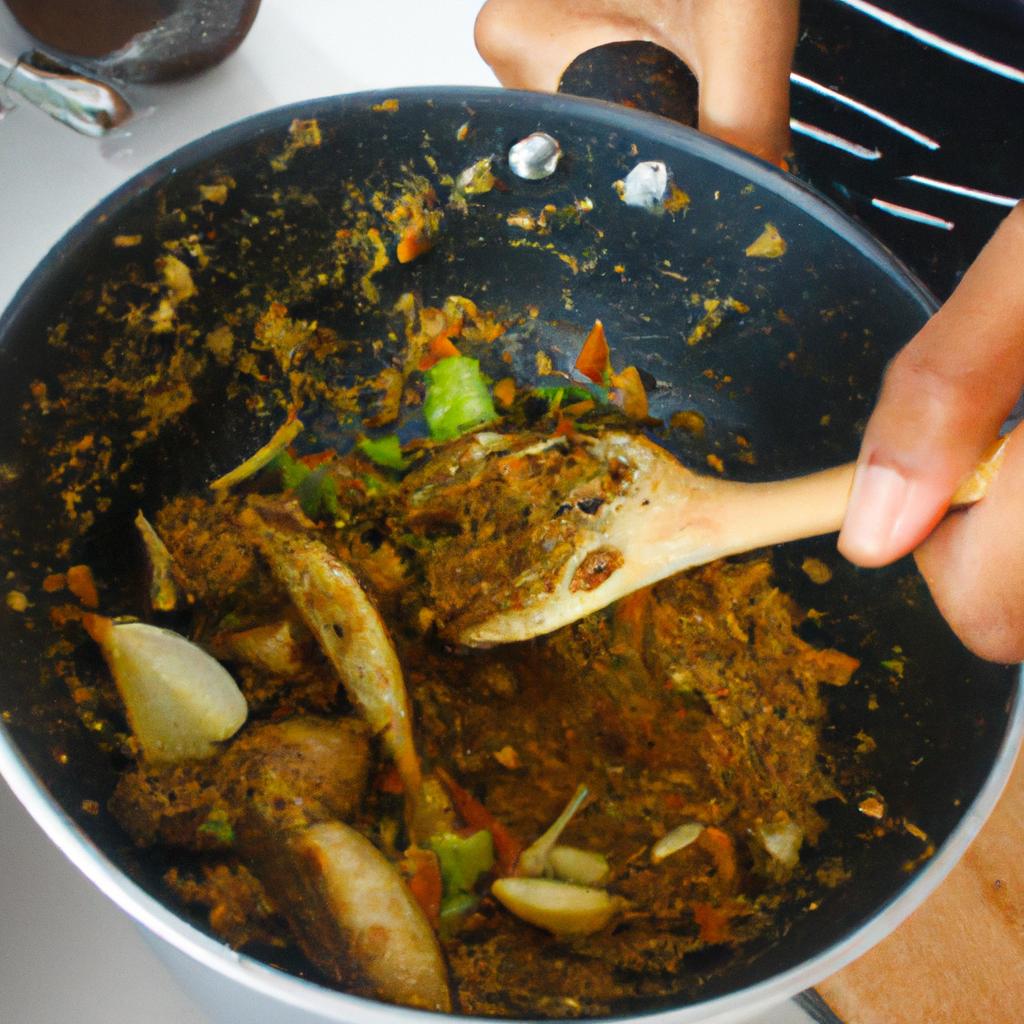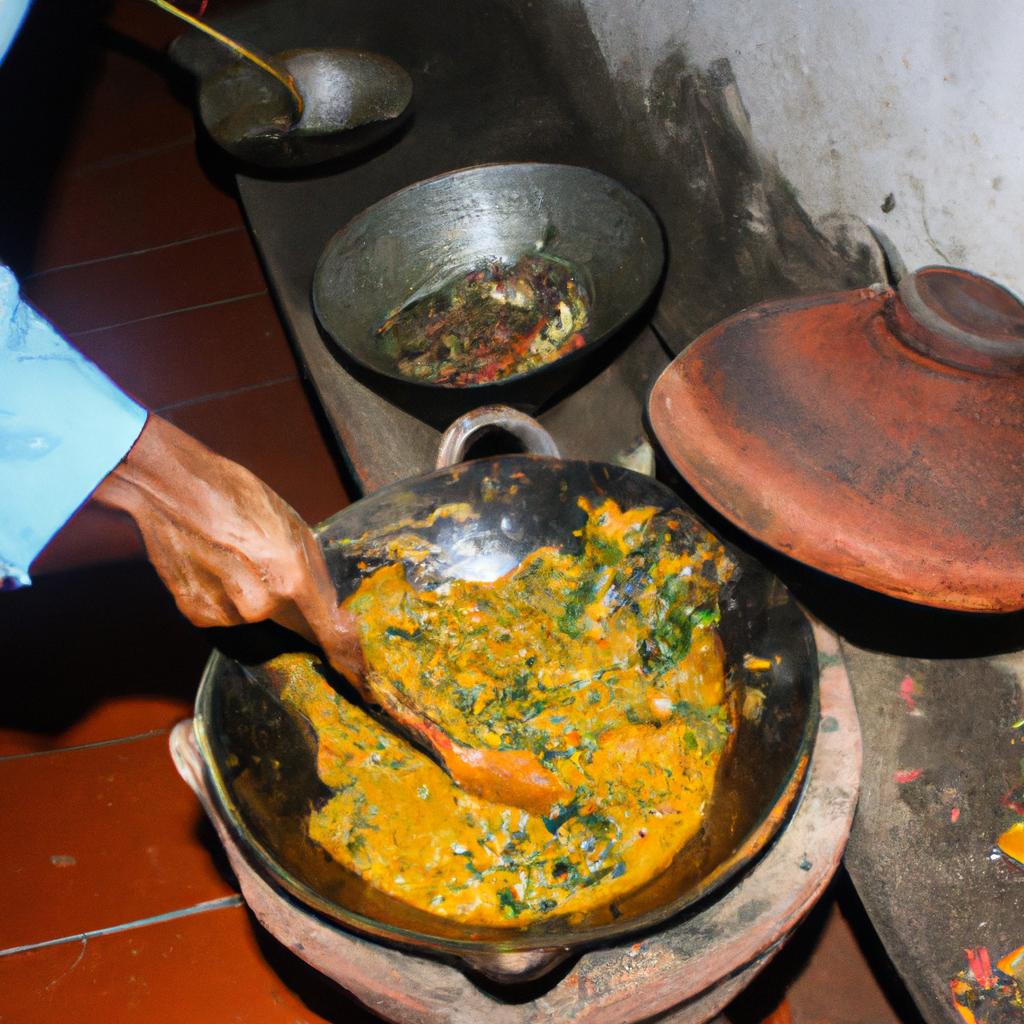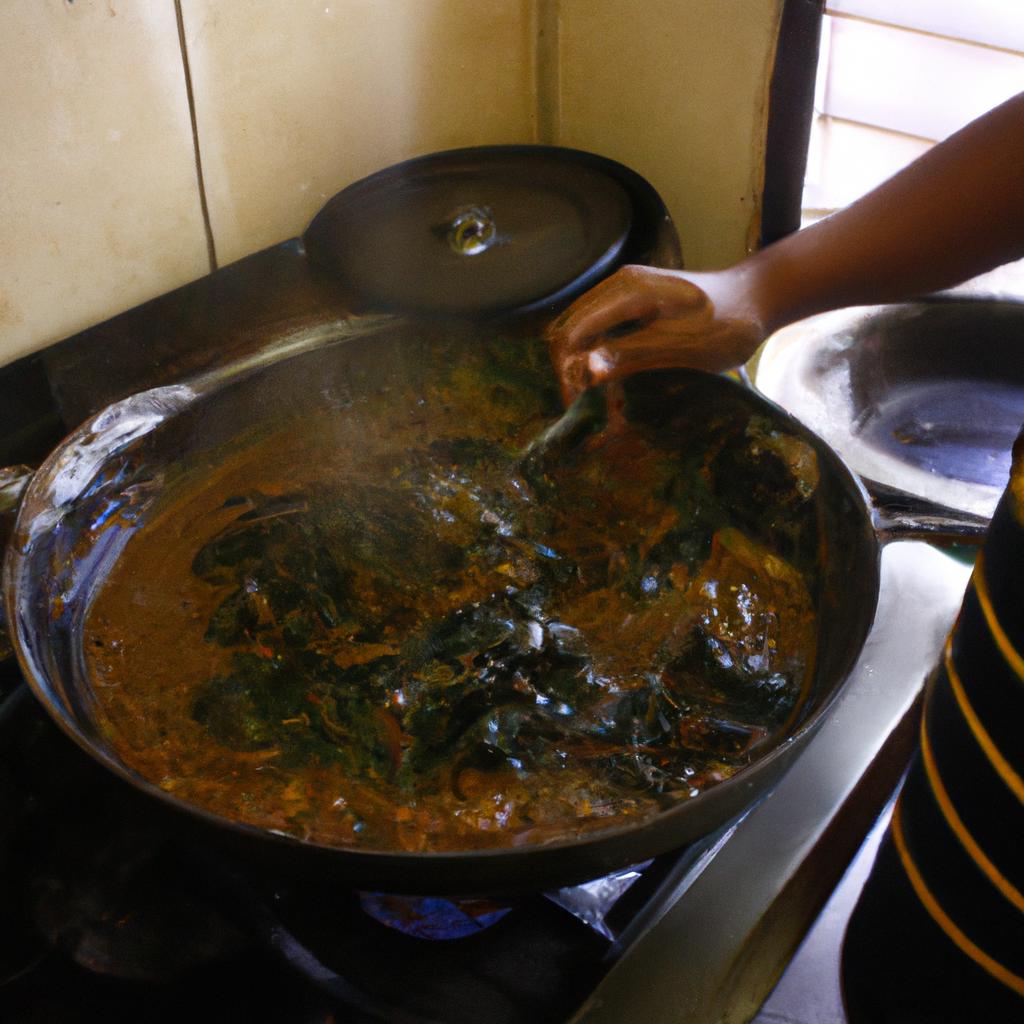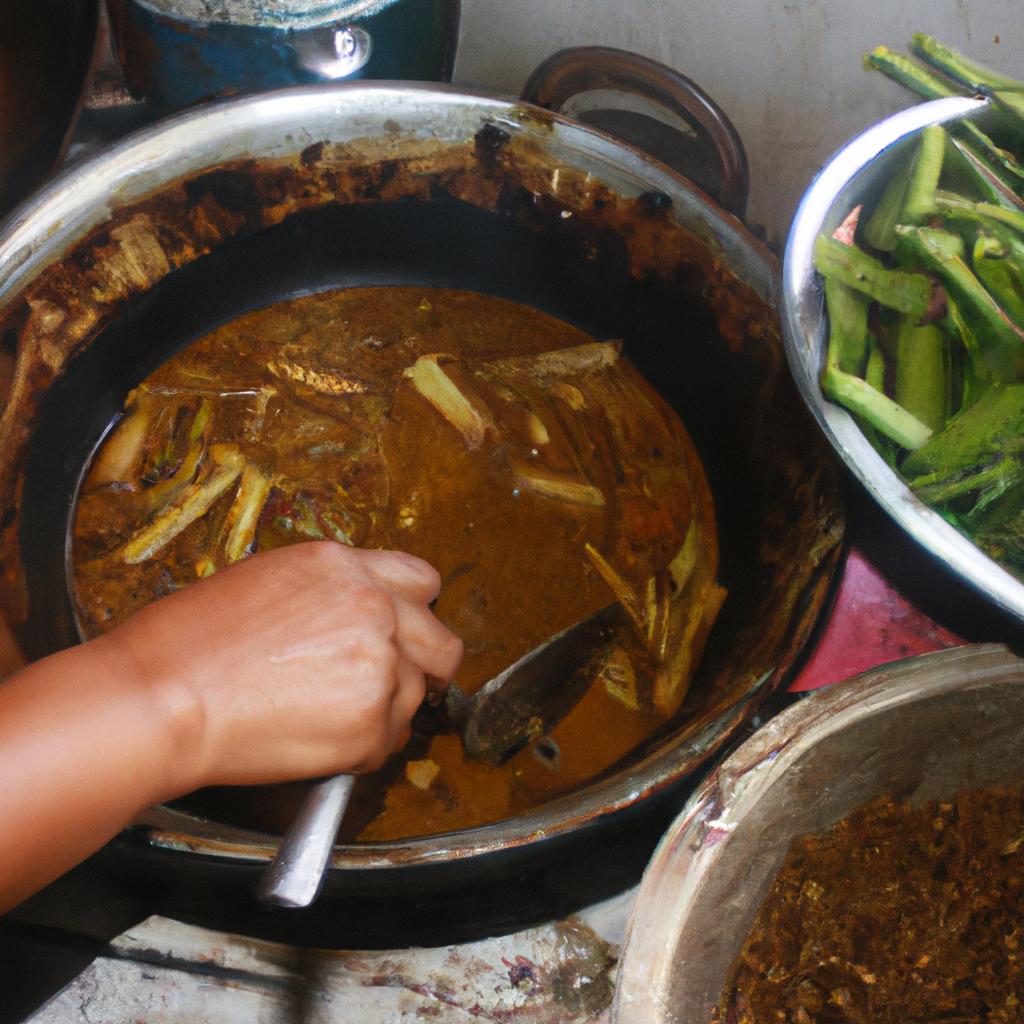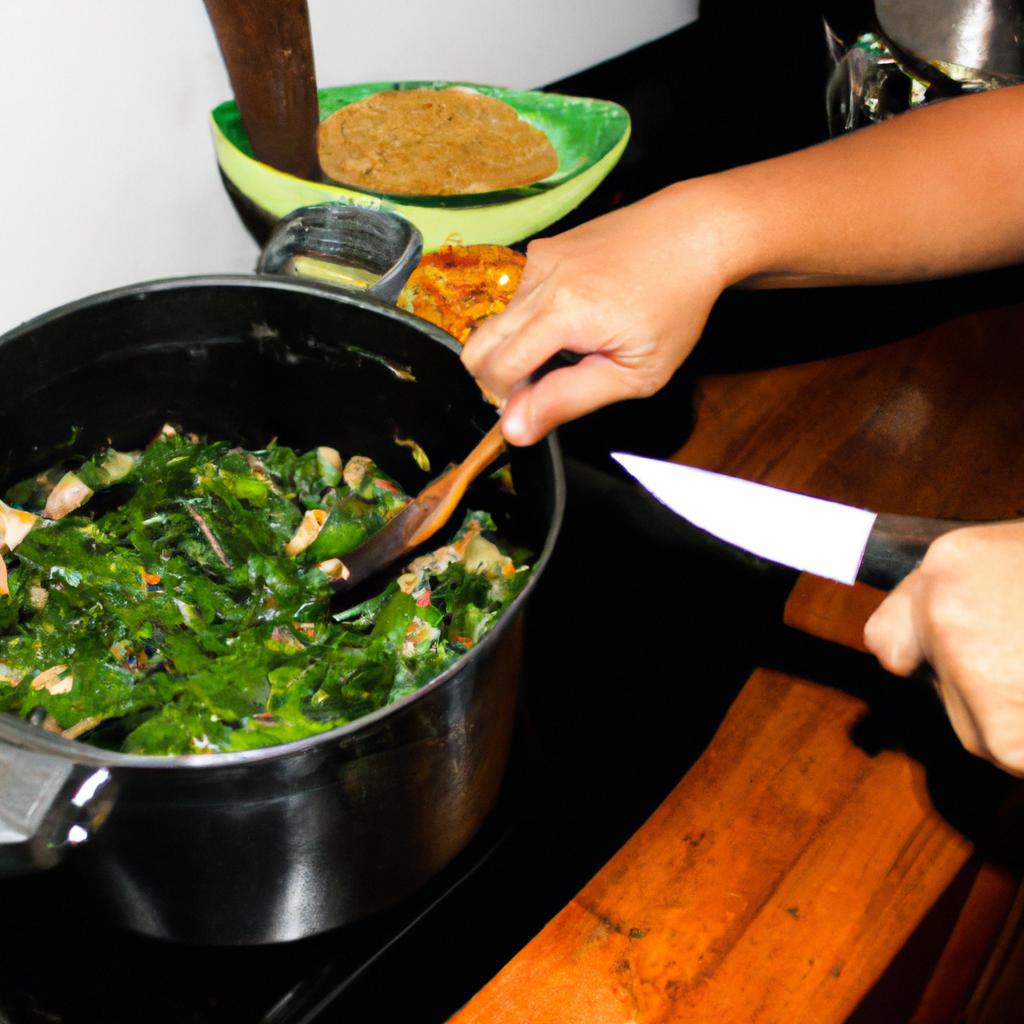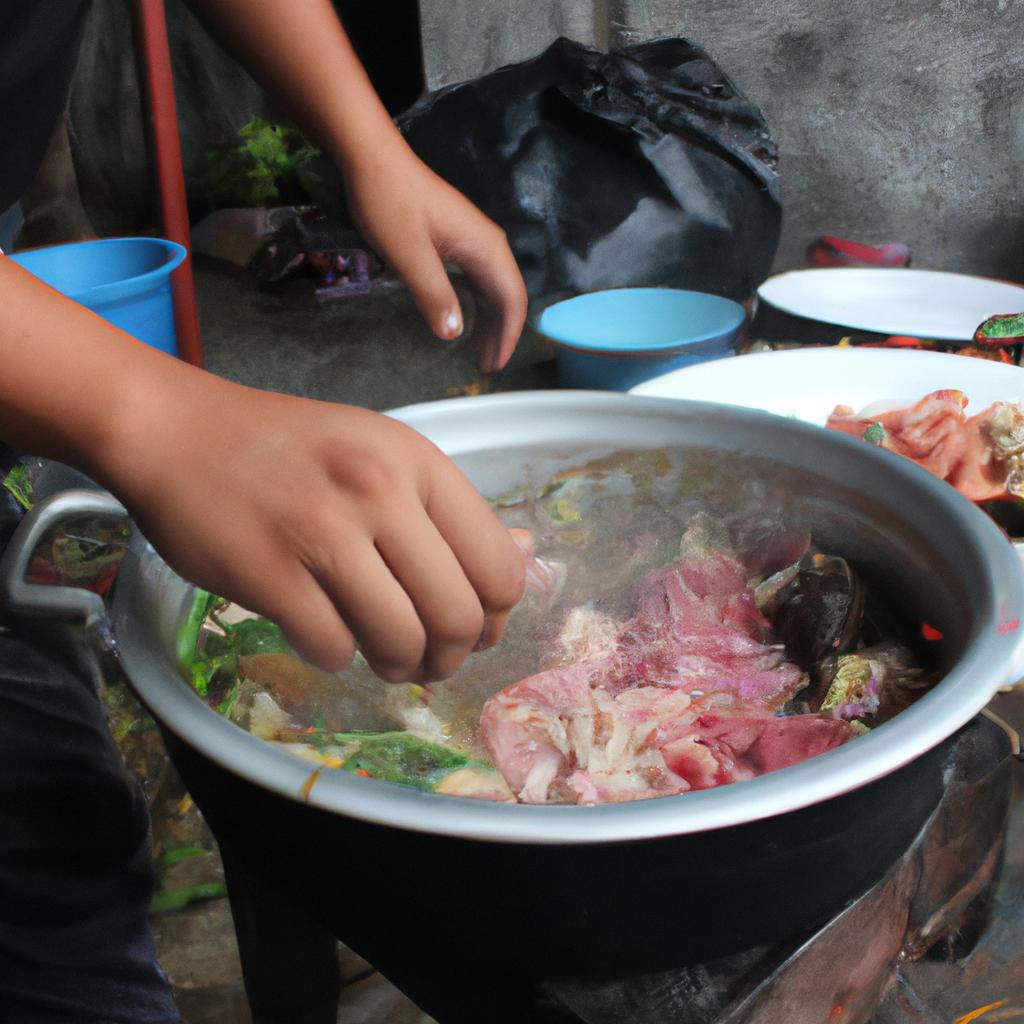Veganizing traditional dishes has become a popular trend in recent years, as more individuals embrace plant-based diets for ethical, environmental, and health reasons. One such dish that has undergone this transformation is Kare-Kare, a beloved Filipino delicacy known for its rich peanut sauce and tender meat. By substituting animal products with plant-based alternatives, chefs and home cooks alike have successfully recreated the flavors and textures of this classic dish while aligning it with their dietary choices. In this article, we will explore the process of veganizing Kare-Kare, examining the various ingredients and techniques used to replicate the authentic taste without compromising on cultural significance.
To illustrate the success of veganizing Kare-Kare, let us consider the case of Maria, a lifelong vegetarian who recently discovered her love for Filipino cuisine. Despite her dietary restrictions, Maria was determined to experience the unique flavors embedded within Kare-Kare. Through experimentation and research, she learned how to replace traditional ingredients like oxtail or tripe with protein-rich substitutes such as tempeh or tofu. By skillfully using ground peanuts or nut butters along with other spices and vegetables commonly found in the original recipe, Maria was able to recreate an equally delectable version of Kare-Kare that satisfied both her taste buds and her ethical values.
One of the key components in veganizing Kare-Kare is finding a suitable meat substitute. Maria decided to use tempeh, a fermented soybean product known for its firm texture and earthy flavor. To achieve a meat-like consistency, she marinated the tempeh in a mixture of soy sauce, vinegar, garlic, and spices before grilling or pan-frying it until golden brown. This step not only added depth of flavor but also helped mimic the tenderness found in traditional Kare-Kare.
Next, Maria tackled the challenge of recreating the rich and creamy peanut sauce that is synonymous with Kare-Kare. Instead of using animal-based fats like lard or butter, she opted for plant-based alternatives such as coconut oil or margarine. She then combined ground peanuts (or peanut butter) with vegetable broth, onion, garlic, annatto seeds (for color), and other seasonings to create a flavorful base for her sauce. To achieve the desired thickness and creaminess, Maria used cornstarch slurry or coconut milk as thickeners.
In addition to the protein-rich meat substitute and peanut sauce, vegetables play an essential role in veganized Kare-Kare. Maria used traditional ingredients like eggplant, string beans (sitaw), bok choy (pechay), and banana blossoms to add texture and variety to her dish. These vegetables were blanched separately before being added to the peanut sauce at the end of cooking to preserve their vibrant colors and crispness.
To complete her veganized Kare-Kare experience, Maria served it with steamed rice or quinoa instead of the usual bagoong (shrimp paste) condiment which contains animal products. For those who still desire a hint of umami flavor, there are vegan-friendly versions available made from fermented soybeans or mushrooms.
By sharing her journey of veganizing Kare-Kare, Maria hopes to inspire others to explore plant-based alternatives and discover the endless possibilities of adapting traditional dishes to suit their dietary choices. She believes that embracing veganism does not mean sacrificing cultural heritage or missing out on beloved flavors; rather, it is an opportunity to celebrate diversity and create new culinary traditions that are inclusive and sustainable.
In conclusion, through careful ingredient selection and creative techniques, it is possible to veganize traditional dishes like Kare-Kare without compromising taste or cultural significance. With more individuals opting for plant-based diets, this trend serves as a testament to the versatility and adaptability of cuisines around the world. So whether you’re a lifelong vegetarian, someone exploring a plant-based lifestyle, or simply curious about new flavors, don’t be afraid to experiment with veganizing your favorite dishes – you might just discover a whole new world of culinary delights!
History of Kare-Kare
History of Kare-Kare
Imagine a Filipino family gathering for a special occasion, with the aroma of rich and flavorful dishes filling the air. Among these traditional delicacies is Kare-Kare, a well-loved dish that has been passed down through generations in Philippine cuisine. This article delves into the history of Kare-Kare and explores how it has evolved over time.
Kare-Kare traces its roots back to pre-colonial Philippines when indigenous tribes would gather wild ingredients from their surroundings to create meals that sustained them in their daily lives. With the arrival of Spanish colonizers, new flavors and cooking techniques were introduced into the local culinary landscape. Over time, Kare-Kare became synonymous with Filipino fiestas and celebrations.
To grasp the significance of this beloved dish, we must understand its cultural context within Filipino society. Here are some key points:
- Cultural Symbolism: Kare-Kare embodies the warmth and hospitality deeply rooted in Filipino culture. It represents unity as families come together to enjoy this hearty meal.
- Traditional Cooking Methods: The original recipe typically involves simmering oxtail or tripe until tender, then combining it with an earthy peanut sauce made from ground roasted peanuts and annatto seeds.
- Variations Across Regions: While Kare-Kare generally follows a similar concept across the country, each region adds its own distinct twist by incorporating local ingredients such as vegetables or seafood.
- Serving Style: Traditionally served with bagoong (fermented shrimp paste), steamed rice, and sometimes accompanied by fermented fish sauce or calamansi juice on the side.
Here’s a table summarizing various regional variations of Kare-Kare:
| Region | Variation |
|---|---|
| Luzon | Classic version using oxtail or tripe |
| Visayas | Seafood-based versions like shrimps or squid |
| Mindanao | Adding vegetables like eggplant and string beans |
| Bicol Region | Introducing a spicy kick with the use of chili peppers |
As Kare-Kare continues to be cherished by Filipinos worldwide, it has also undergone some adaptations to cater to various dietary preferences.
Transitioning into the subsequent section about “Traditional Ingredients and Cooking Methods,” we delve deeper into the components that make up this delectable Filipino delicacy.
Traditional Ingredients and Cooking Methods
From its humble beginnings as a traditional Filipino dish, Kare-Kare has evolved and found its way into the hearts and palates of many. However, with the growing popularity of plant-based diets, there is an increasing demand for vegan alternatives to this beloved delicacy. This section will explore the reasons behind this shift towards plant-based eating and highlight the benefits it brings.
One case study that exemplifies this trend is Maria, a health-conscious individual who recently decided to adopt a vegan lifestyle. As someone who grew up enjoying Kare-Kare at family gatherings, Maria was determined to find a way to continue indulging in this flavorful dish while adhering to her new dietary choices. Like many others in similar situations, she sought out recipes and techniques to veganize Kare-Kare without compromising on taste or cultural authenticity.
The decision to embrace veganism often stems from various motivations, including ethical concerns about animal welfare, environmental sustainability, and personal health goals. By choosing plant-based alternatives like Vegan Kare-Kare, individuals can contribute positively to these causes. Here are some key points showcasing the advantages of opting for vegan versions:
- Lower carbon footprint: Plant-based ingredients require fewer resources and produce fewer greenhouse gas emissions compared to their animal-derived counterparts.
- Healthier choice: Vegan Kare-Kare incorporates nutrient-rich vegetables and legumes that provide essential vitamins, minerals, and fiber while being low in saturated fats.
- Compassionate eating: By eliminating animal products from their diet, individuals support more compassionate food choices aligned with their values.
- Culinary diversity: Exploring plant-based options opens doors to discovering new flavors and cooking methods that expand culinary horizons.
To further illustrate the possibilities of creating delicious vegan dishes inspired by Kare-Kare’s rich heritage, here’s a table highlighting noteworthy substitutes commonly used in Vegan Kare-Kare recipes:
| Traditional Ingredient | Vegan Alternative 1 | Vegan Alternative 2 |
|---|---|---|
| Ox tripe | Jackfruit | Seitan |
| Beef | Mushrooms | TVP (Textured Vegetable Protein) |
| Shrimp | Tofu | Tempeh |
As more individuals like Maria seek vegan alternatives, the demand for plant-based versions of Kare-Kare continues to grow.
Vegan Alternatives for Kare-Kare
Transitioning from the previous section on traditional ingredients and cooking methods, let us now explore the vegan alternatives for Kare-Kare. By replacing animal-based products with plant-based substitutes, individuals can enjoy this classic Filipino delicacy while adhering to a vegan lifestyle. To illustrate the possibilities of veganizing Kare-Kare, we will consider a hypothetical scenario where a group of friends decides to host a dinner party featuring an all-vegan menu.
One popular approach in veganizing Kare-Kare is substituting meat with tofu or tempeh. These soy-based proteins provide texture and absorb flavors well when cooked in the rich peanut sauce. In our hypothetical case, the hosts marinate cubes of firm tofu overnight before pan-frying them until golden brown. This step enhances their taste and allows them to hold up better in the stew-like consistency of Kare-Kare.
When it comes to vegetables, there are numerous options that can add depth and variety to the dish. Some commonly used choices include eggplant, string beans, bok choy, and banana blossoms. For our dinner party scenario, the hosts decide to incorporate all these vegetables into their plant-based Kare-Kare to create a colorful and visually appealing presentation.
To help readers gain an emotional connection with the topic, here is a bullet point list showcasing some benefits of choosing vegan alternatives for Kare-Kare:
- Reduces reliance on animal agriculture
- Supports sustainable food systems
- Promotes compassion towards animals
- Encourages healthier eating habits
Additionally, below is a table highlighting several key differences between traditional Kare-Kare and its veganized version:
| Traditional Kare-Kare | Veganized Kare-Kare |
|---|---|
| Uses oxtail or tripe | Replaces meat with tofu |
| Contains shrimp paste | Omits shrimp paste |
| May contain annatto seeds | May use turmeric instead |
| Uses fish sauce for flavor | Substitutes with soy sauce |
By embracing vegan alternatives, individuals can enjoy the flavors of Kare-Kare while aligning their food choices with their ethical and environmental values. In the subsequent section, we will explore some tips for achieving authentic flavors in plant-based Kare-Kare without compromising on taste or cultural significance.
Tips for Achieving Authentic Flavors
Transition from the previous section:
Having explored vegan alternatives for Kare-Kare, let us now delve into some essential tips that can help you achieve authentic flavors in your plant-based version of this beloved Filipino delicacy.
Tips for Achieving Authentic Flavors
To ensure that your plant-based Kare-Kare retains its traditional taste and appeal, consider the following tips:
-
Choose the right protein substitute: Opt for vegan proteins like tofu, tempeh, or seitan to replace the traditional meat components in Kare-Kare. These options provide texture and absorb flavors well when cooked with a variety of aromatic ingredients.
-
Experiment with different vegetables: While eggplants are commonly used in vegetarian versions of Kare-Kare, feel free to incorporate other veggies such as string beans, bok choy, or even mushrooms to add depth and variety to the dish. This allows you to explore new flavor profiles while still maintaining the essence of this classic Filipino recipe.
-
Mastering the art of peanut sauce: The rich and creamy peanut sauce is at the heart of any great Kare-Kare dish. To make it more vibrant and flavorful without relying solely on peanuts, try blending them with roasted cashews or almonds. Adding sautéed onions and garlic provides an extra layer of complexity to the sauce.
-
Don’t forget shrimp paste (bagoong): Traditionally served alongside Kare-Kare, shrimp paste adds a savory umami element that balances out the richness of the dish. Look for vegan-friendly alternatives made from fermented soybeans or black beans if you prefer not to use animal-derived condiments.
- Experience a harmonious blend of textures and flavors.
- Discover exciting combinations by incorporating various vegetables.
- Elevate your peanut sauce game through experimentation.
- Find alternative condiments that offer similar umami notes.
Markdown table:
| Vegan Protein Options | Recommended Vegetables | Enhanced Peanut Sauce Ideas | Alternative Shrimp Paste |
|---|---|---|---|
| Tofu | String Beans | Blend with roasted cashews | Fermented soybeans |
| Tempeh | Bok Choy | Mix in sautéed onions | Black beans |
| Seitan | Mushrooms | Incorporate garlic |
By following these tips, you can create a plant-based Kare-Kare that not only satisfies your cravings but also honors the traditional flavors of this Filipino delicacy.
Transition to subsequent section:
Now that we have explored how to capture authentic flavors in vegan Kare-Kare, let us delve into the health benefits that come along with enjoying this plant-based version.
Health Benefits of Plant-Based Kare-Kare
Transitioning from the previous section’s discussion on achieving authentic flavors in veganizing Kare-Kare, let us now delve into the health benefits that come with opting for a plant-based version of this beloved Filipino delicacy. To illustrate its potential impact, we will explore a hypothetical case study of individuals who have incorporated plant-based Kare-Kare into their diet.
Consider a group of participants who decided to adopt a plant-based lifestyle and included vegan Kare-Kare as one of their staple dishes. After several weeks, these individuals reported various positive changes in their overall well-being. Here are some notable health benefits associated with consuming plant-based Kare-Kare:
-
Increased Nutrient Intake: By replacing traditional meat ingredients such as oxtail or tripe with nutrient-rich alternatives like tofu or seitan, plant-based Kare-Kare provides essential vitamins, minerals, and dietary fiber that contribute to improved nutrition.
-
Lower Cholesterol Levels: Plant-based diets are naturally low in cholesterol and saturated fats, which can lead to reduced levels of bad cholesterol (LDL) and a decreased risk of cardiovascular diseases.
-
Enhanced Digestive Health: The abundance of vegetables used in vegan Kare-Kare offers an excellent source of dietary fiber, promoting healthy digestion while preventing constipation and other gastrointestinal issues.
-
Weight Management Support: As plant-based meals tend to be lower in calories compared to their animal protein counterparts, incorporating vegan Kare-Kare into your diet may assist in weight management efforts without compromising taste or satisfaction.
To further emphasize the advantages of embracing a plant-based approach to enjoying Kare-Kare, consider the following table showcasing a comparison between traditional and vegan versions:
| Health Benefits | Traditional Kare-Kare | Veganized Kare-Kare |
|---|---|---|
| Reduced LDL Cholesterol Levels | ❌ Higher due to animal fat content | ✔️ Decreased due to absence of animal products |
| Improved Digestion | ❌ Limited fiber content | ✔️ Abundant in dietary fiber from vegetables |
| Lower Calorie Intake | ❌ Higher calorie density from meat and oil | ✔️ Fewer calories from plant-based ingredients |
As evident, transitioning to a veganized version of Kare-Kare offers numerous health benefits that can positively impact one’s overall well-being. By adopting this approach, individuals can enjoy the authentic flavors they love while prioritizing their health.
Transitioning seamlessly into our next section about popular variations of vegan Kare-Kare, we will explore how different regions have put their unique twist on this Filipino favorite.
Popular Variations of Vegan Kare-Kare
Having explored the health benefits of adopting a plant-based approach to traditional Kare-Kare, it is now imperative to examine some popular variations that have emerged in response to the growing demand for vegan alternatives. These adaptations not only cater to individuals following a plant-based diet but also offer unique flavors and textures that can be enjoyed by everyone.
Vegan Kare-Kare Case Study:
To illustrate the versatility and appeal of veganized versions, let’s consider a hypothetical case study involving a family who decides to transition from their usual meat-centric meal choices to explore alternative options. This family consists of four members – Lisa, John, their teenage daughter Mia, and young son Ethan. They are excited about incorporating more plant-based meals into their diet without compromising on taste or cultural heritage.
- Discover new ways of enjoying an iconic Filipino dish.
- Promote sustainable food practices through reduced reliance on animal products.
- Nourish your body with nutrient-dense ingredients packed with vitamins and minerals.
- Support local farmers by embracing locally-sourced produce.
Table showcasing Different Variations:
Here is a table highlighting various adaptations of vegan Kare-Kare recipes that showcase creativity and innovation in reinventing this beloved Filipino delicacy:
| Variation | Key Ingredients | Unique Flavor Profiles |
|---|---|---|
| Peanut-Free | Almonds or cashews instead of peanuts | Creamy texture with nutty undertones |
| Mushroom-Lovers | Assorted mushrooms (shiitake, oyster, etc.) | Earthy flavor with rich umami notes |
| Tofu-Tastic | Firm tofu cubes | Silky-smooth consistency |
| Tempeh-Temptation | Fermented soybean cakes | Savory and slightly nutty taste |
These variations offer a wealth of options for those curious about exploring plant-based alternatives to traditional Kare-Kare. By embracing these adaptations, individuals can enjoy the rich flavors and unique textures that make this Filipino dish so beloved while also aligning with their dietary preferences and values.
Incorporating veganized recipes into one’s culinary repertoire not only expands horizons but also encourages sustainable food practices by reducing reliance on animal products. Additionally, incorporating nutrient-dense ingredients found in plant-based Kare-Kare ensures that the body receives essential vitamins and minerals necessary for overall well-being.
Through supporting local farmers and utilizing locally-sourced produce, individuals play an active role in promoting community resilience and fostering a stronger connection between consumers and producers. These conscious choices contribute to a more sustainable food system that benefits both human health and the environment.
As we continue our exploration of vegan Kare-Kare, let us delve deeper into specific variations that encapsulate innovative approaches to this traditional Filipino delicacy.

